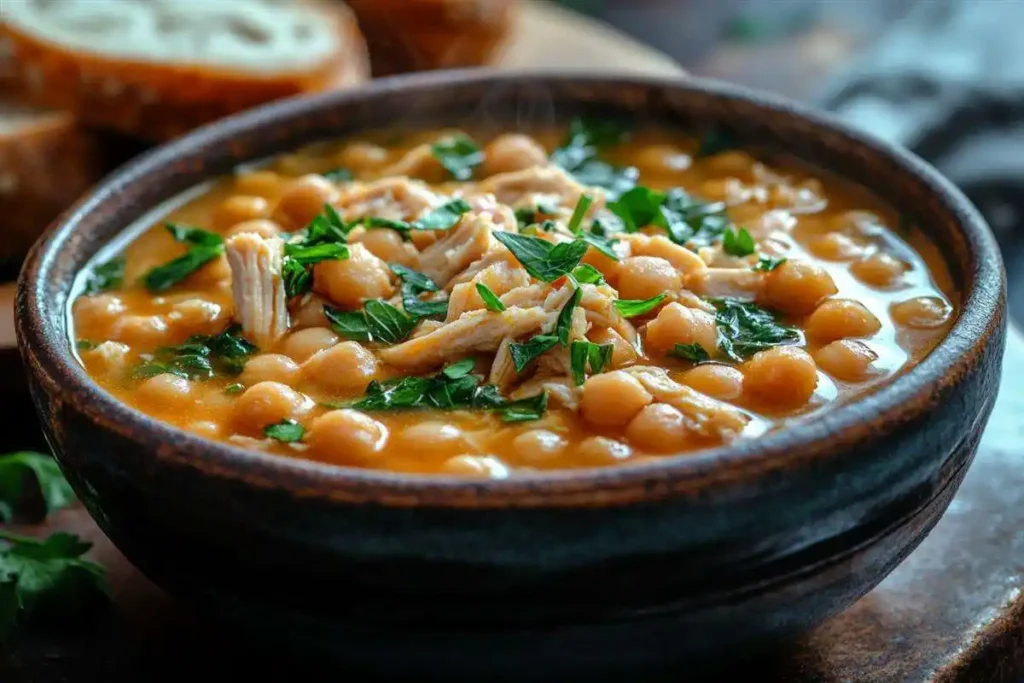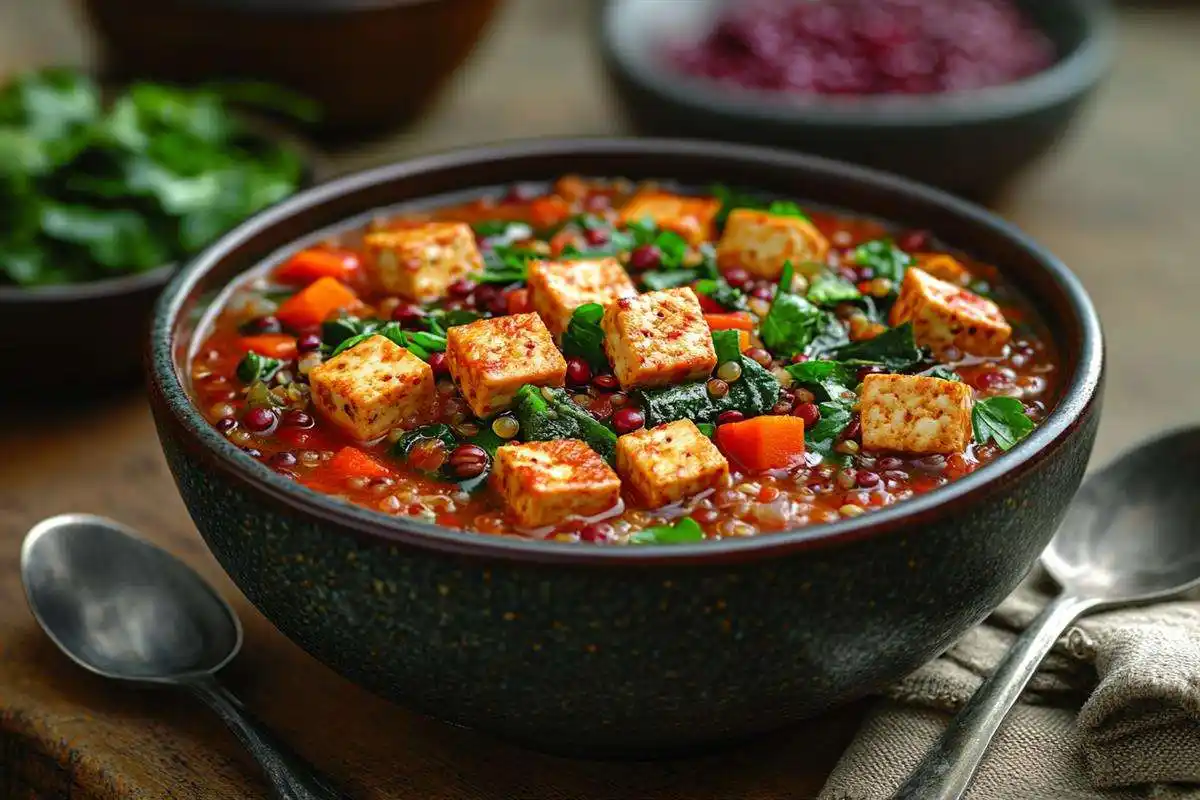Soup is a classic comfort food, but did you know it can also be a protein powerhouse? By making a few smart ingredient swaps, you can transform your favorite soups into nutrient-packed meals. Whether you’re aiming to boost your energy, fuel your workouts, or simply enjoy a heartier dish, this guide will walk you through protein swaps in soups that cater to both plant-based and meat-based preferences. From innovative ingredients to practical tips, let’s dive into the delicious world of protein-rich soups.
Table of Contents
Introduction to protein swaps in soups
The Importance of Protein in the Diet
Protein is the building block of life literally. It plays a crucial role in repairing tissues, building muscle, and keeping you full for longer. Yet, many of us don’t get enough of this essential nutrient in our daily meals. Soups, often viewed as light starters or side dishes, are an underrated avenue for increasing protein intake. With a few simple tweaks, your soup can become a protein-rich main course.
Benefits of High-Protein Soups
What’s the deal with high-protein soups? For starters, they’re a fantastic way to combine flavor and nutrition. Adding more protein not only improves satiety but also stabilizes blood sugar levels, making it ideal for anyone looking to manage their weight or boost their energy. High-protein soups are versatile they fit into various diets, from keto to vegan, and can easily accommodate dietary restrictions.
Overview of Common Protein Sources in Soups
Traditional soup recipes often rely on basic proteins like chicken or beans. While these are great options, the possibilities don’t stop there. Ever considered adding tofu, quinoa, or even protein-enriched pasta? These unconventional swaps can amplify your soup’s protein profile while introducing exciting textures and flavors.
Plant-Based Protein Swaps in Soups
Incorporating plant-based proteins into your soups is a fantastic way to boost nutrition while catering to various dietary preferences. Let’s explore some versatile options.
Legumes and Beans: Chickpeas, Lentils, and Black Beans
Legumes are a staple in many cuisines, and for good reason. They’re not only rich in protein but also high in fiber, which aids digestion. Adding chickpeas, lentils, or black beans to your soup can enhance its nutritional profile significantly. For instance, a cup of cooked lentils provides about 18 grams of protein. To incorporate them:
- Chickpeas: These can be added whole to brothy soups or blended for a creamier texture.
- Lentils: Red lentils cook quickly and dissolve into the soup, thickening it, while green or brown lentils hold their shape, adding texture.
- Black Beans: Perfect for hearty soups like black bean soup or added to vegetable soups for extra protein.
Tofu and Tempeh
Tofu and tempeh are excellent protein swaps in soups, especially for those following a plant-based diet. Tofu, made from soybeans, has a mild flavor and can absorb the taste of the soup it’s added to. Tempeh, also soy-based, has a firmer texture and a nuttier flavor. To use them:
- Tofu: Silken tofu can be blended into soups for a creamy consistency, while firm tofu can be cubed and added to broths.
- Tempeh: Slice thinly or cube and simmer in the soup to infuse it with flavor.
Quinoa and Other Whole Grains
Quinoa is a complete protein, meaning it contains all nine essential amino acids. It’s a fantastic addition to soups, providing about 8 grams of protein per cooked cup. Other whole grains like barley or farro also contribute protein and add heartiness. To incorporate:
- Quinoa: Rinse thoroughly and add directly to the soup; it cooks in about 15 minutes.
- Barley/Farro: These grains take longer to cook, so it’s best to add them at the beginning or use pre-cooked versions.
By integrating these plant-based proteins, your soups will not only be more filling but also nutritionally balanced.

Animal-Based Protein Swaps
For those who include animal products in their diet, there are several ways to enhance the protein content of soups.
Lean Poultry: Chicken and Turkey
Chicken and turkey are classic additions to soups, offering high-quality protein with relatively low fat. To maximize their benefits:
- Selecting the Right Cuts: Opt for boneless, skinless breasts for lean protein or thighs for a bit more flavor.
- Cooking Methods: Poach the poultry in the broth to keep it tender, then shred or dice before adding back to the soup.
Seafood Options: Fish and Shellfish
Incorporating fish and shellfish can elevate your soup’s protein content while adding unique flavors. Options include:
- Fish: Firm varieties like cod or salmon hold up well in soups. Add them towards the end of cooking to prevent overcooking.
- Shellfish: Shrimp or clams cook quickly and can be added in the last few minutes.
Dairy Additions: Greek Yogurt and Cheese
Dairy products can enhance both the creaminess and protein content of soups.
- Greek Yogurt: Stir in a dollop just before serving to add tanginess and creaminess without excessive fat.
- Cheese: Hard cheeses like Parmesan can be sprinkled on top, while softer cheeses can be melted in for richness.
By utilizing these animal-based proteins, you can create hearty, satisfying soups that meet your dietary needs.
Innovative Protein-Enriched Ingredients
Elevating your soup’s protein content doesn’t have to be conventional. Let’s explore some creative protein swaps in soups that can add both nutrition and flavor.
Bone Broth
Bone broth is more than just a flavorful base; it’s a protein-rich addition to any soup. Made by simmering animal bones and connective tissues, bone broth releases collagen and amino acids, contributing to joint health and digestion. To incorporate bone broth:
- Homemade vs. Store-Bought: While homemade bone broth allows control over ingredients and flavor, high-quality store-bought options are convenient and time-saving.
- Usage: Substitute regular broth with bone broth in your favorite soup recipes to enhance protein content effortlessly.
Protein-Rich Pasta Alternatives
Traditional pasta can be swapped with protein-enriched alternatives to boost your soup’s nutritional profile. Options include:
- Chickpea and Lentil-Based Pastas: These alternatives offer higher protein and fiber compared to regular pasta. They maintain a firm texture, making them suitable for soups.
- Cooking Tips: Cook the pasta separately until al dente, then add to the soup to prevent overcooking and maintain texture.
Incorporating Eggs
Eggs are a versatile and quick way to add protein to soups. Methods include:
- Egg Drop Technique: Gently pour beaten eggs into simmering broth while stirring to create delicate egg ribbons, as seen in traditional egg drop soup.
- Poaching: Crack eggs directly into the soup during the final minutes of cooking. The hot broth will poach the eggs, adding richness and protein.
By experimenting with these innovative ingredients, you can discover new flavors and textures while enhancing the protein content of your soups.

Practical Tips for Implementing Protein Swaps in Soups
Successfully incorporating protein swaps in soups requires a balance of flavors, textures, and cooking techniques. Here are some practical tips to guide you:
Balancing Flavors and Textures
- Complementary Ingredients: Ensure that the added protein sources harmonize with existing flavors. For instance, tofu pairs well with miso-based soups, while beans complement tomato-based broths.
- Texture Considerations: Vary textures by combining creamy elements like Greek yogurt with crunchy toppings such as roasted chickpeas.
Adjusting Cooking Times for Different Proteins
- Pre-Cooking: Some proteins, like beans and certain grains, may require pre-cooking to achieve the desired tenderness without overcooking other soup components.
- Staggered Addition: Add delicate proteins, such as seafood or leafy greens, towards the end of cooking to prevent them from becoming tough or mushy.
Meal Prep and Storage Considerations
- Batch Cooking: Prepare large quantities of protein-rich soups and store them in portioned containers for quick, nutritious meals throughout the week.
- Storage Tips: Allow soups to cool before refrigerating to maintain quality. Most soups can be stored in the refrigerator for up to four days or frozen for longer preservation.
By following these practical tips, you can seamlessly integrate protein swaps into your soups, creating satisfying and nutritious meals tailored to your preferences.
💡For more recipes, follow me on Facebook and Pinterest.
Frequently Asked Questions
What can I add to soup for more protein?
There are countless ways to enhance the protein content in soups. Common options include adding legumes like lentils, chickpeas, or black beans. For a creamy texture, try blending silken tofu or stirring in Greek yogurt. You can also use bone broth as a base, which adds both flavor and protein.
What is another way to increase protein besides adding beans to a soup?
If beans aren’t your thing, consider other protein swaps in soups. Quinoa is an excellent plant-based alternative that provides all nine essential amino acids. For animal-based options, try adding chicken, fish, or shrimp. Even eggs can elevate your soup use the egg drop technique or poach them directly in the broth.
Can I put protein powder in my soup?
Yes, but with care! Unflavored protein powder works best in soups to avoid altering the flavor. Stir it in gradually at the end of cooking to prevent clumping. It’s a convenient way to boost the protein content without affecting the soup’s texture.
How do you increase the nutritional value in soup?
To make your soup more nutritious, combine protein swaps in soups with plenty of vegetables, whole grains, and healthy fats. Using bone broth, adding leafy greens, and incorporating nutrient-dense toppings like seeds or nuts can create a balanced and satisfying meal.
Conclusion
Soup is more than a simple starter; with the right protein swaps in soups, it can be transformed into a hearty, protein-rich meal. Whether you’re using plant-based options like tofu and quinoa, or animal-based ingredients such as chicken or bone broth, the possibilities are endless. These swaps not only boost protein but also enhance flavors and textures, making your soups even more enjoyable.
Experiment with these ideas to create soups that are as nutritious as they are delicious. Remember, a few thoughtful additions can make all the difference in crafting meals that nourish both body and soul.

Protein-Rich Soups
Ingredients
Plant-Based Proteins
- 1 cup chickpeas Can be added whole or blended for a creamy texture.
- 1 cup lentils Red lentils cook quickly; green or brown retain their shape.
- 1 cup black beans Perfect for hearty soups.
- 1 block tofu Silken for blending or firm for cubing.
- 1 block tempeh Slice or cube before adding to soups.
- 1 cup quinoa Cook in about 15 minutes.
- 1 cup barley Add at the beginning or use pre-cooked versions.
Animal-Based Proteins
- 1 lb chicken breast Boneless and skinless recommended.
- 1 lb fish (cod or salmon) Add towards the end of cooking.
- 1 cup shrimp Cook quickly, add in the last few minutes.
- 1 cup Greek yogurt Add just before serving for creaminess.
- 1/2 cup Parmesan cheese Sprinkle on top or melt in.
Innovative Ingredients
- 4 cups bone broth Substitute regular broth for added protein.
- 8 oz protein-rich pasta Cook separately and add to soup.
- 2 eggs beaten eggs Use egg drop technique or poach directly in broth.
Instructions
Preparation
- Gather all ingredients and prepare them based on the type of protein you plan to use.
- If using grains like quinoa, barley, or pre-cooked proteins, prepare them according to package instructions.
Cooking
- In a large pot, bring your choice of bone broth to a simmer.
- Start by adding legumes or grains that require longer cooking times.
- After 15 minutes, add protein sources like chicken or tofu and let simmer.
- Add delicate proteins like seafood and eggs towards the end to avoid overcooking.
- Mix in dairy options just before serving for added creaminess.

